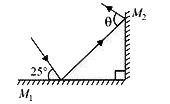Demostrate that a light beam reflected from three mutually perpendicular plane mirrors in succession reverses its direction.
we can assume three mutually perpendicular plane mirror
(x-y) plane Normal unit vector is ˆk
(y - z) plane Normal unit vector is ˆi
(z - x) plane Normal unit vector is ˆj
ˆe1= aˆi + bˆj + cˆk is a unit vector incident on The first mirror after reflection through
( x - y) plane mirror the unit vector of reflected ray. ˆe2 =aˆi + bˆj- cˆk and this ray incidents on the mirror (y-z) plane and reflected ray
ˆe3 = aˆi + bˆj- cˆk and finally thisray incidents on the mirror (z - x) plane after reflection
ˆe4 =-aˆi-bˆj-cˆk
i.e. ˆe4 = −ˆe1 this means, final ray reverses its direction

Topper's Solved these Questions
- BOOK - NARAYNACHAPTER - RAY OPTICS AND OPTICAL INSTRAUMENTS EXERCISE - CUQ (REFLECTION)9videos
RAY OPTICS AND OPTICAL INSTRAUMENTS
- BOOK - NARAYNACHAPTER - RAY OPTICS AND OPTICAL INSTRAUMENTS EXERCISE - CUQ (REFRECTION)28videos
RAY OPTICS AND OPTICAL INSTRAUMENTS
- BOOK - NARAYNACHAPTER - NUCLEI EXERCISE - ASSERTION & REASON5videos
NUCLEI
- BOOK - NARAYNACHAPTER - SEMI CONDUCTOR DEVICESEXERCISE - Level-II (H.W)36videos
SEMI CONDUCTOR DEVICES
Similar Questions
Knowledge Check
- Question 1 - Select One
A ray of light is reflected by two perpendicular plane mirrors as shown. The angle θ is equal to:
 A65∘B25∘C50∘D90∘
A65∘B25∘C50∘D90∘ - Question 2 - Select One
When the light is reflected from the surface of the mirror, its speed and wavelength will
AincreasesBdecreasesCremains sameDmay increase or may decrease - Question 3 - Select One
Two beams, A and B, of plane polarised light with mutually perpendicular planes of polarisation are seen through a polarised light with mutually perpendicular planes of polarisation are seen through a polaroid. From the position when the beam A has maximum intensity (and beam B has zero intensity). a rotation of Polaroid through 30∘ makes the two beams appear equally bright. If the intiial intensities of the two beams are IAandIB respectively, then IA/IB equals :
A1/3B3C3/2D1
A light ray incident on a plane mirror gets reflected from it. Another plane mirror is placed such that the reflected ray from the first mirror is incident on it If the reflected ray from the second mirror travels perpendicular to the indecent ray on the first mirror, determine the angle between two plane mirrors.
View SolutionA light ray gets reflected from a pair of mutually ⊥ mirrors, not necessarily along axes. The intersection point of mirrors is at origin. The incident light ray is along y=x+2 . If the light ray strikes both mirrors in succession, then it may get reflected finally along the line:
View SolutionWhat is the angle of reflection when a ray of light falls normally on a plane mirror?
View SolutionOn a glass plate, a light beam is incident at an angle of 60∘. If the reflected and the refracted rays are mutually perpendicular, the refractive index of glass is
View SolutionWhen light is reflected from a mirror a change occurs in its :
View Solution
